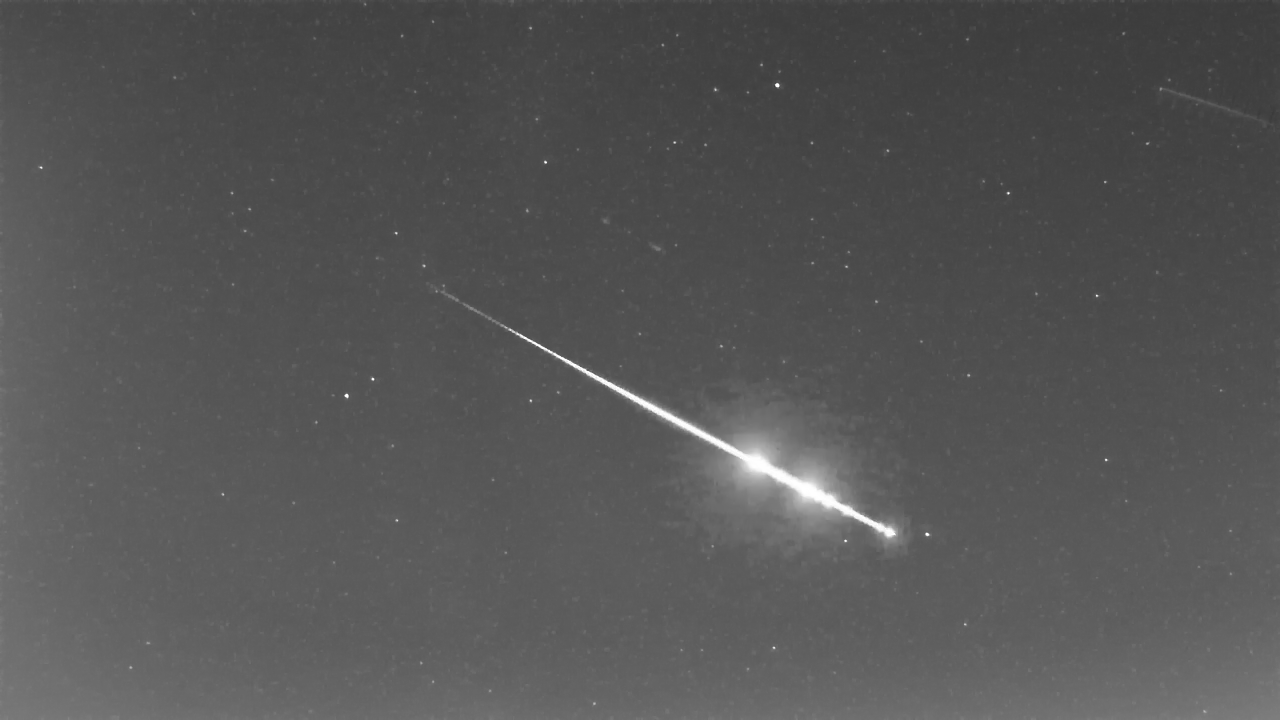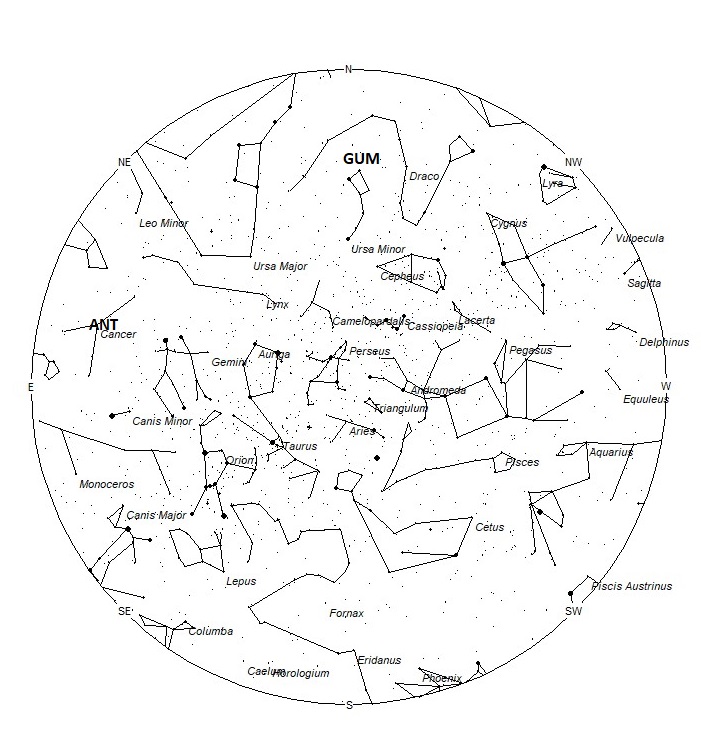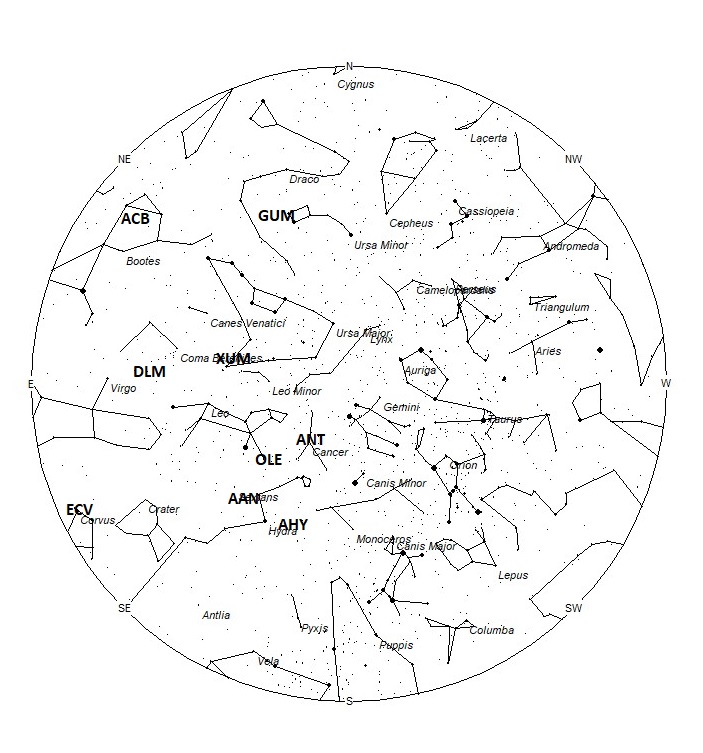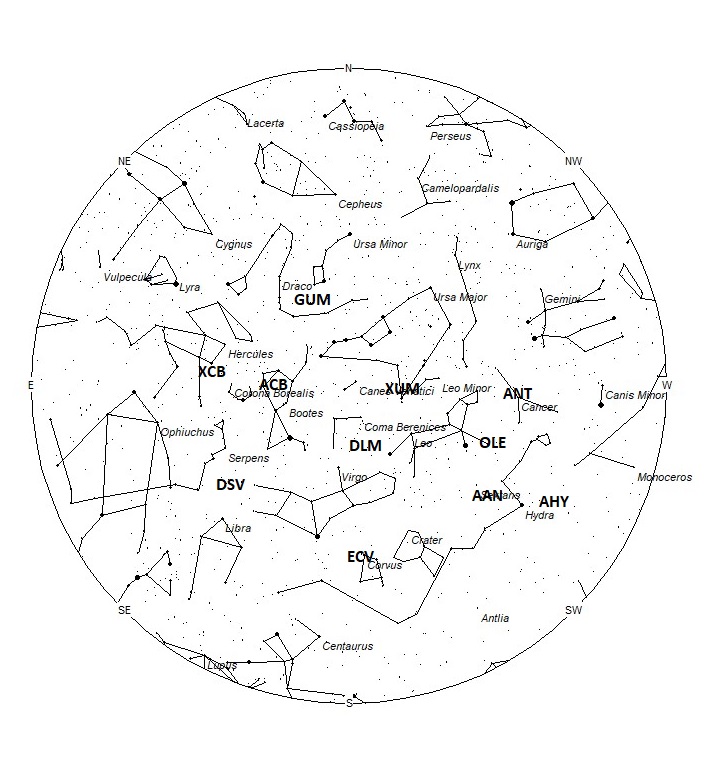 Richard Bassom captured this impressive fireball at 08:48 UT on 26 October 2020, from Ringwood, England. Notice the multiple bursts along the trail and at the end. Credit Richard Bassom
Richard Bassom captured this impressive fireball at 08:48 UT on 26 October 2020, from Ringwood, England. Notice the multiple bursts along the trail and at the end. Credit Richard BassomDuring this period, the moon reaches its first quarter phase on Thursday January 21st. At this time, the moon is located 90 degrees east of the sun in the sky and sets near 0100 local standard time. This weekend the waxing crescent moon will be present in the western sky after dusk but will soon set, leaving the remainder of the night free from interfering moonlight. The estimated total hourly meteor rates for evening observers this week is near 3 as seen from mid-northern latitudes and 3 as seen from tropical southern locations (25S). For morning observers, the estimated total hourly rates should be near 14 as seen from mid-northern latitudes (45N) and 11 as seen from tropical southern locations (25S). The actual rates will also depend on factors such as personal light and motion perception, local weather conditions, alertness, and experience in watching meteor activity. Note that the hourly rates listed below are estimates as viewed from dark sky sites away from urban light sources. Observers viewing from urban areas will see less activity as only the brighter meteors will be visible from such locations.
The radiant (the area of the sky where meteors appear to shoot from) positions and rates listed below are exact for Saturday night/Sunday morning January 16/17. These positions do not change greatly day to day so the listed coordinates may be used during this entire period. Most star atlases (available at science stores and planetariums) will provide maps with grid lines of the celestial coordinates so that you may find out exactly where these positions are located in the sky. A planisphere or computer planetarium program is also useful in showing the sky at any time of night on any date of the year. Activity from each radiant is best seen when it is positioned highest in the sky, either due north or south along the meridian, depending on your latitude. It must be remembered that meteor activity is rarely seen at the radiant position. Rather they shoot outwards from the radiant, so it is best to center your field of view so that the radiant lies at the edge and not the center. Viewing there will allow you to easily trace the path of each meteor back to the radiant (if it is a shower member) or in another direction if it is sporadic. Meteor activity is not seen from radiants that are located far below the horizon. The positions below are listed in a west to east manner in order of right ascension (celestial longitude). The positions listed first are located further west therefore are accessible earlier in the night while those listed further down the list rise later in the night.
These sources of meteoric activity are expected to be active this week.
.
The Anthelion (ANT) radiant is active from a position located at 08:36 (129) +19. This position lies in central Cancer, 2 degrees northwest of the 4th magnitude star known as Asellus Australis (delta Cancri). This radiant is a very large oval some thirty degrees wide by fifteen degrees high. Activity from this radiant can appear from more than one constellation., This week though, the Anthelion activity is limited to the constellation of Cancer. There are several lists that have the delta Cancrids currently active, but we include them with the Anthelions as the celestial positions overlap. The position listed here is for the center of the radiant. This radiant is best placed near 01:00 Local Standard Time (LST) when it lies on the meridian and is highest in the sky. Rates at this time should be near 3 per hour as seen from the northern hemisphere and 2 per hour as seen from south of the equator. With an entry velocity of 30 km/sec., the average Anthelion meteor would be of slow velocity.
The alpha Hydrids (AHY) were discovered by Dr. Peter Brown and are mentioned in his article “A meteoroid stream survey using the Canadian Meteor Orbit Radar”. This shower is active from December 16 through January 27 with maximum activity occurring on January 5th. The radiant is currently located at 09:00 (135) -11. This position lies in the western Hydra, 5 degrees southwest of the 2nd magnitude star known as Alphard (alpha Hydrae). These meteors are best seen near 0200 LST when the radiant lies highest above the horizon. At 42 km/sec. the alpha Hydrids produce meteors of medium velocity. Expected rates this week are less than 1 per hour no matter your location.
The Omicron Leonids (OLE) were discovered by Damir Šegon and the Croatian Meteor Network team based on studying SonotaCo and CMN observations (SonotaCo 2007-2011, CMN 2007-2010). These meteors are active from December 16 through February 4. Maximum activity occurs on January 9th. The radiant is currently located at 09:41 (145) +09. This position lies in southwestern Leo, 1 degree southwest of the 4th magnitude star known as omicron Leonis. These meteors are best seen near 0200 LST when the radiant lies highest above the horizon. At 42 km/sec. the omicron Leonids produce meteors of medium velocity. Expected rates this week are less than 1 per hour no matter your location.
Toward the end of this period the first of the alpha Antliids (AAN) may be seen. These meteors were discovered by D. P. Galligan and W. J. Baggaley by using the Advanced Meteor Orbit Radar in New Zealand*. This very weak display is active from January 20 through February 10. There are two weak maximums occurring near January 26 and February 1. On January 20, the radiant lies at 09:49 (147) -05. This position lies in western Sextans, 7 degrees northeast of the 2nd magnitude star known as Alphard, alpha Hydrae). I’m not certain why these meteors were called alpha Antliids as this position lies 20 degrees north of the constellation of Antlia. These meteors are best seen near 0200 LST when the radiant lies highest above the horizon. At 44 km/sec. the alpha Antliids produce meteors of medium velocity. Expected rates this week are less than 1 per hour no matter your location.
*Gary Kronk, Meteor Showers-An Annotated Catalog, 2nd Edition Page 45
The January xi Ursae Majorids (XUM) were discovered by Japanese observers of SonotoCo based on video observations in 2007-2008. This shower is active from January 10-25, with maximum activity occurring on the 19th. The radiant is currently located at 11:14 (169) +34, which lies in southern Ursa Major, 2 degrees northwest of the 3rd magnitude star known as Alula Borealis (nu Ursae Majoris). These meteors are best seen near 04:00 LST when the radiant lies highest above the horizon. Hourly rates should be near 1 as seen from the northern hemisphere and less than 1 as seen from south of the equator. These meteors encounter the atmosphere at 42 km/sec., which would produce meteors of average velocity.
The December Leonis Minorids (DLM) are a shower of long duration active from November 22 through February 10th. Maximum occurred near December 20th. The radiant is currently located at 12:25 (186) +18. This position lies in western Coma Berenices, 2 degrees west of the faint star known as 24 Comae Berenices. These meteors are best seen near 0500 LST when the radiant lies highest above the horizon. Current hourly rates are expected to be near 1 as seen from the northern hemisphere and less than 1 as seen from south of the equator. At 63 km/sec. the December Leonis Minorids produce mostly swift meteors.
The eta Corvids (ECV) were recently discovered by Sirko Molau and the IMO Video Meteor Network Team. This stream is active from January 16-29, with maximum activity occurring on the 22nd. The current position of the radiant is 12:30 (187) -17, which places the radiant in central Corvus, near the spot occupied by the 3rd magnitude star known as Gienah (gamma Corvi A). These meteors are best seen near 0500 LST when the radiant lies highest above the horizon. Current hourly rates would be less than 1 per hour no matter your location. At 67 km/sec. these meteors would be fast.
Later next week meteors from the alpha Coronae Borealids (ACB) should begin appearing. These meteors were discovered by John Greaves using data from SonotoCo. Activity from this source spans from January 20 to February 10 with maximum activity occurring on January 27. On the 20th, the radiant is located at 14:56 (224) +34. This position lies in in eastern Bootes, 4 degrees west of the 3rd magnitude star known as Princeps (delta Bootis). These meteors are best seen during the last few hours before dawn, when the radiant lies highest in a dark sky. Current rates should be less than 1 per hour no matter your location. These meteors encounter the atmosphere at 53 km/sec., which would produce meteors of medium-swift velocity.
The gamma Ursae Minorids (GUM) are another source discovered by Dr. Peter Brown and associates. These meteors are active from January 9-20, with maximum activity occurring near January 18. The radiant is currently located at 15:13 (228) +70 which places it southern Ursa Minor, 2 degrees south of the 3rd magnitude star known as Pherkad (gamma Ursae Minoris). These meteors are best seen during the last few hours before dawn, when the radiant lies highest in a dark sky. Current rates should be near 1 per hour as seen from the northern hemisphere and less than 1 as seen from south of the equator. These meteors encounter the atmosphere at 30 km/sec., which would produce meteors of medium-slow velocity.
The December sigma Virginids (DSV) is a source of long duration also discovered by John Greaves using the data of SonotaCo. This source is active from November 22 through January 25. Peak rates occurred near December 21st. The current radiant location is at 15:18 (229) 00, which places it in southwestern Serpens Caput, 1 degree southwest of the faint star known as 6 Serpens Caput. Current hourly rates should be less than 1 no matter your location. These meteors are best seen during the last dark hour before dawn, when the radiant lies highest above the horizon in a dark sky. At 66 km/sec. the December Sigma Virginids would produce mostly swift meteors.
The xi Coronae Borealids (XCB) were another source discovered by Dr. Peter Brown and associates. These meteors are active from January 5-25 with maximum occurring near January 15. The radiant is currently located near 16:46 (252) +30, which places it in western Hercules, 2 degrees south of the 3rd magnitude star known as zeta Herculis. Hourly rates would be less than 1 per hour no matter your location. These meteors are best seen during the last dark hour before dawn, when the radiant lies highest above the horizon in a dark sky. At 46 km/sec. this source would produce meteors of medium velocity.
No matter your location, sporadic rates should be near 9 meteors per hour during the last hour before dawn as seen from rural observing sites. Evening rates would be near 3 per hour. Locations between these two extremes would see activity between the listed figures.
The list below offers the information from above in tabular form. Rates and positions are exact for Saturday night/Sunday morning except where noted in the shower descriptions.
| SHOWER | DATE OF MAXIMUM ACTIVITY | CELESTIAL POSITION | ENTRY VELOCITY | CULMINATION | HOURLY RATE | CLASS |
| RA (RA in Deg.) DEC | Km/Sec | Local Standard Time | North-South | |||
| Anthelion (ANT) | – | 08:36 (129) +19 | 30 | 01:00 | 3 – 2 | II |
| alpha Hydrids (AHY) | Jan 05 | 09:00 (135) -11 | 42 | 02:00 | <1 – <1 | IV |
| omicron Leonids (OLE) | Jan 09 | 09:41 (145) +09 | 42 | 02:00 | <1 – <1 | IV |
| alpha Antliids (AAN) | Jan 26 | 09:49 (147) -05 | 44 | 02:00 | <1 – <1 | IV |
| January xi Ursae Majorids (XUM) | Jan 19 | 11:14 (169) +34 | 42 | 04:00 | 1 – <1 | IV |
| December Leonis Minorids (DLM) | Dec 20 | 12:25 (186) +18 | 63 | 05:00 | 1 – <1 | II |
| eta Corvids (ECV) | Jan 22 | 12:30 (187) -17 | 67 | 05:00 | <1 – <1 | IV |
| alpha Coronae Borealids (ACB) | Jan 27 | 14:56 (224) +34 | 53 | 08:00 | <1 – <1 | IV |
| gamma Ursae Minorids (GUM) | Jan 18 | 15:13 (228) +70 | 30 | 08:00 | 1 – <1 | IV |
| December Sigma Virginids (DSV) | Dec 21 | 15:18 (229) 00 | 66 | 08:00 | <1 – <1 | IV |
| xi Coronae Borealids (XCB) | Jan 15 | 16:46 (252) +30 | 46 | 09:00 | <1 – <1 | IV |
 American Meteor Society
American Meteor Society



I’m excited to say that l actually saw my first meteors on 01/16/21. I had the opportunity to record it on my phone WOW!
I think I saw three meteorites/comets today (1/17/21) at 5:10pm. All three seem to be aiming at Hawaii/Aistralia direction viewing from San Francisco Cali.
Not trying to criticize anyone but Gerry you probably saw a meteor not a comet… just saying.
I just witnessed a very bright meteor slowly traveling through the western sky. Dimmed into a small red light for merely a second and disappeared. Almost looked like a traveling planet. So neat!
Just saw 2 XUM through my brand new Gosky 12×55 monocular viewing from Virginia. Coolest Birthday present ever!!!
I don’t know what I saw… It was a Very bright almost NEON Green Streaking across the sky on the morning of January 21/21. It was about 7:45am, was walking to work. looked up as I was crossing the Street. It was streaking across the sky, then like it exploded than it was gone. I have never seen anything like it before. I was googling for about a week straight to see if anybody else had seen it, There was nobody talking about it, on TV or Radio from what I seen or heard.. I live in LaRonge Saskatchewan, looking “South” when it happened. It looked like the Blue Fireball everyone is talking about today (feb 22/21) but it was Green.
Just want to know if anybody else has seen it or reported seeing it.